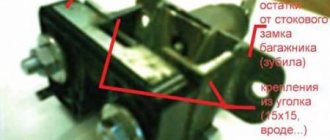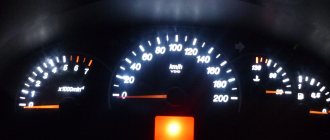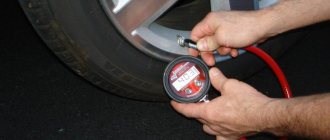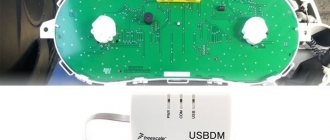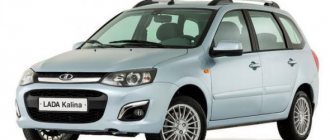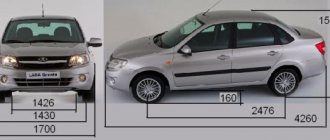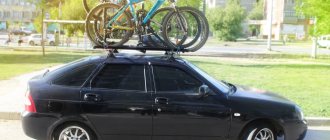How much oil to pour into Kalina engine
The manufacturer recommends pouring 3.5 liters of oil into the engine crankcase. It is this volume that is necessary for the normal operation and functioning of the car’s lubrication system. But if for some reason it is not possible to measure the volume, fill in engine oil until it is between the MIN and MAX marks on the dipstick.
Lack of lubrication in the engine can lead to oil starvation, which will have a very negative impact on the service life. If the level is too high, if it exceeds the maximum mark on the dipstick, it is possible to select some of it into the air filter bellows through the breather hose. From there it can get to the mass air flow sensor, which can lead to premature failure of this sensor.
Tank volume Lada Kalina station wagon: photo
Often those who have just bought or are planning to buy a car ask questions about how much oil should be poured into the engine or gearbox, as well as how much fuel will fit into the tank of a particular car. This article will discuss this issue.
Fuel tank volume for Kalina Universal
The volume of the gas tank according to the passport is 50 liters. The Lada Kalina hatchback and sedan have the same tank volume.
Regardless of the material used to make the tank itself in the Lada Kalina (plastic or metal), its volume is 50 liters.
Here everyone has to decide for themselves how much fuel to pour into the tank.
It is not recommended to allow a situation where the fuel in the tank runs out completely. This may air the fuel system. Also, operating a fuel pump without fuel can lead to its failure and its replacement. It is advisable to refuel the car when its level drops to the red mark on the sensor.
Other parameters
Since the question was asked as the volume of the tank, and the volume of the coolant tank and the volume of the windshield washer reservoir also fit this parameter, we will consider the remaining rated volumes
Engine oil quantity
The manufacturer recommends pouring 3.5 liters of oil into the engine. It is with this quantity that the engine will operate as efficiently as possible, and all working units in it will be lubricated.
Upgraded engine oil dipstick, enlarged grooves
If it is not possible to accurately measure the amount of oil recommended by the manufacturer, then you need to fill it up to about on the dipstick.
If the engine oil is below 0, this will negatively affect the operation of the engine. Also, if there is more than the recommended amount, this will lead to the excess entering the air filter through the breather. From there it will get into the mass air flow sensor and cause damage to the sensor. Also, if there is excess oil in the engine, the seals can wear out or become damaged.
Transmission oil
The manufacturer recommends pouring 3.1 liters of oil into the gearbox. The manufacturer also notes that it is recommended to exceed the specified volume by a certain amount.
Transmission oil dipstick close up
For example, the oil level on the dipstick should be approximately 5 millimeters above the maximum value. This is necessary in order to ensure better lubrication of the fifth gear gears, which, in turn, will help increase the service life of the unit.
Cooling system
Draining the antifreeze
In Lada Kalina it is necessary to fill in antifreeze with a volume of 7.84 liters. If you notice visually, then this amount of liquid in the tank will be in the middle of it. It is not recommended to reduce the fluid level excessively, as this will negatively affect engine cooling. Also, you should not exceed the level, since at high pressure the pipes may burst.
Glass washer
Windshield washer tank
On Kalina with a sedan body, the glass washer is provided only at the front. For other body types (hatchback, station wagon) it is also available at the rear. Regardless of this, the capacity of the tank is the same on all cars. Its volume is five liters.
conclusions
Knowing these points, you will be able to control the level of working and consumable fluids in the main components of the Lada Kalina car, as well as top them up on time.
carfrance.ru
How much oil to pour into the Kalina gearbox
The factory's recommendation for filling volume for a gearbox states that 3.1 liters of gear oil is required for the gearbox. But according to many manuals of official publications, you can read that it is best to exceed this volume by some value.
Here it’s the other way around, it’s better that the level on the dipstick is slightly higher than the maximum, about 5 mm. This is necessary so that the fifth gear gears are better lubricated. Accordingly, this advice will extend the life of the transmission, or fifth speed in particular.
How much gasoline does Kalina's fuel tank hold?
Regardless of what material your car’s fuel tank is made of: metal or plastic, its volume is the same and is 50 liters. Here, everyone decides at their own discretion how much gasoline to fill, but it is worth noting that it is undesirable to allow a situation in which the engine stalls due to running out of gasoline.
If the fuel pump often runs “dry”, so to speak, then this is fraught with a negative outcome, including complete failure of the fuel pump motor. So, when the fuel level in the tank drops to the red mark, it is advisable to refuel.
Capacity of the windshield and rear window washer reservoir (hatchback or station wagon)
On the Kalina sedan car, the washer is only on the windshield, since on similar body types it is not needed at the rear. But on a station wagon or hatchback there is also a rear washer. But the capacity of the washer fluid reservoir is the same for any of the three body types and is 5 liters.
Main filling volumes
Quite often, many novice owners are interested in questions such as: how much gasoline will fit into the tank or how much oil to pour into the engine. Because there are many similar questions and every day at least 1000 people look for such information, it was decided to post extended information on the main refueling volumes of the Lada Kalina on the blog.
Let's start, perhaps, with frequently encountered questions, and we will list the least popular of them in order of priority.
How to choose and replace antifreeze on Kalina: step-by-step instructions
LADA Kalina is an excellent domestically produced family car. It is distinguished by reliability, good maneuverability, attractive appearance and low price. It is chosen not only by beginners, but also by experienced drivers.
During the operation of the machine, a lot of questions arise. Most of them are related to consumables. Replacing them is an important undertaking and affects the operation of the car.
The manufacturer recommends choosing only high-quality liquids from manufacturers whose reputation is impeccable. Each unit uses its own type of oil and fills it in a certain amount. Violations of these requirements lead to serious system failures. Therefore, you should not neglect them.
So, it is recommended to fill 3.5 liters of liquid into the engine crankcase. This volume will ensure normal operation of the lubrication system. If it is not possible to measure it, then a probe will help, on which there are two marks MIN and MAX. A lack of consumables in the unit will lead to oil starvation, which will negatively affect the service life of the device.
Exact information about how much oil is needed for a particular Lada Kalina unit, and which one to choose, is given in the table below.
| Filling/lubrication point | Filling volume, liters | Name of oil/liquid | |
| Fuel tank | 50 | Unleaded gasoline with an octane rating of at least 92 | |
| Engine lubrication system | 1.4 16V VAZ-11194, 1.6 VAZ-21114 81, 1.6 VAZ-11186 | 3,5 | Synthetic fluid QUARTZ 9000, viscosity 5W40, Lukoil SAE 5W-40, Shell Helix HX7 5W-40 |
| 1.6 16V VAZ-21126, 1.6 16V VAZ-21127 | 2,9-3,2 | ||
| Engine cooling and interior heating system | 7,84 | OZh-65SK; Lada-A40; OZH-K Tosol-TS; OZh-40 Tosol-TS; OZh-65 Tosol-TS; Antifreeze G-48; AGIP Antifreeze Extra; | |
| Manual transmission | VAZ 2181 | 2,2 | SAE 75W-80 and 75W-85 (-40°C to 35°C), SAE 75W-90 (-40°C to 45°C), 80W-85 (from -26°C to 35°C), SAE 80W-90 (-26°C to 45°C), SAE 85W-90 (from -12°C to 45°C and above) |
| VAZ 1118 and 1119 | 3,5 | ||
| Hydraulic brake system | 0,45 | DOT-4, ELF 650 SAE J 1703 | |
| Windshield washer reservoir | 5,0 | Windshield washer fluid | |
| Tailgate glass washer reservoir (for hatchback and station wagon vehicles) | 5,0 | Windshield washer fluid | |
| Front wheel drive joints | — | Grease CV joint-4, CV joint-4M, SPECTROL CV joint MoS2, MOUKOT VN2461C | |
| Steering gear housing | — | Lubricant FIOL-1 | |
| Front suspension ball joints, steering rod joints | — | ShRB-4 grease | |
| Battery leads and wire terminals | — | Automatic lubricant VTV-1 in aerosol packaging, CIATIM-201, -221 |
PS: Dear car owners, if you have your own information on this topic, please tell us about it in the comments or write an email to the site administration.
Lada Kalina Hatchback Blueberry Logbook FAQ
Note!
At engine operating temperature, the fluid heats up to 100 degrees - you can get burned. Sometimes you urgently need to cool the liquid - unscrew the cap of the expansion tank. Act carefully and smoothly, and completely remove the lid only if the hissing sound disappears, otherwise the air inside the tank will knock out the lid and the liquid will flow out in a column - everything around will get dirty, and you can get burned. It is best to work with a cold engine.
Lada Kalina Hatchback RED LABEL Logbook We are going through the suspension. Replacing daisies, silent blocks and grant crabs
Coolant must be poured into the Lada Kalina car in order for it to perform several of its functions, such as maintaining the temperature (temperature sensor), cooling the engine, and it must also eliminate the unpleasant odor that enters the cabin from the street. For all these “moments” to work 100%, Kalina antifreeze must be replaced on time.
Several additional functions that coolant performs:
- Maintains normal temperature (temperature sensor) during engine operation.
- Maintains low temperature (temperature sensor) in PC operation. Using hydraulic fluid, which must be poured into the automatic transmission.
- The interior is heated in winter. Due to the fact that antifreeze passes through the heater, it provides warmth in the car. The liquid heated by the motor is inflated by a fan. And thus, the interior warms up in winter.
- Eliminates unpleasant odor in the driver's cabin (passenger compartment).
So if you smell any of these signs, even a fleeting, incomprehensible odor, then you need to think about it and replace the liquid substance. Also, antifreeze or antifreeze in a Lada Kalina car should be replaced every two years or every 45,000 km, whichever comes first. Because over time, the quality deteriorates and the element may succumb to corrosion.
How to change coolant
Before changing the coolant, you need to figure out where the procedure is located, how many liters need to be filled, where the indicator should be located and how to determine the level. You need to find the expansion tank. It is located in the engine compartment, on the mudguard on the left, in the area of the bracket and is held on by clamps.
https://www.youtube.com/watch?v=CGGDk3F1hNY
Then purchase 10 liters of antifreeze or antifreeze. Which is better, judge for yourself. Antifreeze is slightly inferior in functionality to antifreeze, besides, antifreeze is mainly sold ready-made, which makes it much easier to use
To completely change the cooling water in a 2nd generation Lada Kalina/Kalina car, you need 7.8 liters of antifreeze or antifreeze, depending on what you choose. Reddish Felix antifreeze is poured from the factory.
To completely replace the coolant (cooling water), we will need to purchase either one 10-liter canister, or two 5-liter containers.
If reddish antifreeze was poured from the factory, then we recommend creating a replacement with reddish one.
- AGA 003Z (-40*) reddish 10l cost from 1000 rub.
- Professional Premium G-12 reddish 10 l cost from 700 rub.
- SINTEC LUX G-12 reddish 10l cost from 1000 rub.
- FELIX Carbox-40 (10 l) red price from 950 rub.
- NIAGARA G12 (10 l) red price from 800 rub.
- Arctic Circle G12 (10 l) red price from 700 rub.
All of the manufacturers mentioned above have proven themselves, so antifreeze from these manufacturers can be used for replacement.
- Container for draining old antifreeze for 6-8 liters.
- 16mm head
- 13mm socket wrench for removing the starter on the 16 valve version of Kalina
It is better to create a replacement for a cool engine. Before replacement, you should release the pressure in the system by unscrewing the cap of the expansion tank. In order to freely access the drain plug, you need to remove the middle mud flap.
Note that the technology for replacing the refrigerant in versions of LADA Kalina with an 8-valve engine is somewhat different from the sequence of work on variations of 16-valve engines. In the latter case, to provide access to the block drain plug, you will need to remove the starter fasteners. And before work, we’ll find out how to drain antifreeze correctly.
Procedure for 8-valve Kalinas
- We release the pressure in the previously indicated way.
- We dismantle the crankcase protection.
- We place the prepared container under the drain hole (located on the right side of the radiator).
- You can regulate the pressure of the drained stream of liquid by tightening or removing the plug on the tank. We carry out this manipulation, focusing on the situation.
- Having unscrewed the radiator cap, we wait for the liquid to completely drain.
- Now we move to the motor block.
- The drain plug is located under the ignition coil.
- To unscrew the specified plug, we use a 13-size wrench.
- We substitute the same container and collect the remaining liquid into it.
The antifreeze replacement is complete.
In order not to overheat the engine, you need to monitor the coolant level - depending on whether you have antifreeze or antifreeze filled. Monitor the fluid level in the expansion tank, and also check the pipes and their connections, as well as the pump, for signs of leakage. Complete replacement of the filter according to the factory regulations is recommended once every 5 years or every 75 thousand km.
We replace the coolant after 75,000 km or after five years, whichever comes first. For refilling, a liquid with a freezing point of no higher than -40 ° C is used.
The volume of the engine cooling system, including the interior heating system, is 7.84 liters.
To complete the work, you will need a wide container with a volume of at least 8 liters.
It is more convenient to carry out the work on an inspection ditch or overpass.
Mixing coolants of different brands is not allowed.
Execution Sequence
1. We prepare the car for work.
2. Remove the engine splash guard or crankcase protection (if installed).
3. Place a container with a volume of at least 8 liters under the radiator drain hole.
To reduce splashing of coolant when draining it, do not remove the expansion tank cap before performing the following operation.
4. Unscrew the radiator drain plug and drain the liquid into a container.
5. Having moved the container under the cylinder block, use a 13 mm socket wrench to unscrew the drain plug of the cylinder block and drain the remaining liquid in it.
6. After the liquid stops leaking from the cylinder block, screw both plugs into place.
7. Unscrew and remove the cap of the expansion tank and install a funnel in the tank.
8. Fill the expansion tank with new coolant.
Use coolant with a freezing point 10-15 °C below the average winter temperature in the region in which the vehicle is operated.
9. Fill the liquid up to the top mark of the expansion tank. We start the engine and let it run at high speeds until the electric fan turns on. When the level in the tank drops, add liquid.
General information on coolant
ANTIFREEZE FREEZES
A mixture of antifreeze and water is an example of a composition whose freezing point is different from the freezing temperatures of its components - pure antifreeze and pure water.
Freezing point of liquids
Pure water 0°C
Pure antifreeze* -18°С
Mixture: 50/50 -37°С
Mixture: 70% antifreeze to 30% water -64°C
*Pure antifreeze is usually a 95% ethylene glycol solution containing 2% to 3% water, and 2% to 3% additives. Depending on the percentage of water, antifreeze sold in cans freezes at temperatures ranging from -13°C to -22°C. Therefore, the easiest way is to simply remember that antifreeze usually freezes at a temperature of about -18°C.
How much gasoline does Kalina's fuel tank hold?
Regardless of what material the fuel tank of your car is made of: metal or plastic, its volume is the same and is 50 liters. Here everyone decides at their own discretion how much gasoline to fill, but it should be noted that this situation should not be allowed, in which the engine stalls due to running out of gas.
If the fuel pump often runs dry, so to speak, then this is fraught with a bad ending, including complete failure of the fuel pump motor. So, when the fuel level in the tank drops to the reddish mark, it is better to refuel.
Add a comment Cancel reply
You must be logged in to post a comment.
When choosing a car, it is important to study not only its technical characteristics, but also the dimensions of the body, interior and trunk. Compare these values with competitors and evaluate all the pros and cons of the car before purchasing. In this reference article you will find all the overall dimensions of the Lada Kalina 2nd generation that interest you, as well as the dimensions of the trunk and interior of this car.
Technical characteristics of Kalina station wagon
| Engines | 1.6 l, 8 cells | 1.4 l, 16 cells |
| Length, mm | 4040 | 4040 |
| Width, mm | 1700 | 1700 |
| Height, mm | 1500 | 1500 |
| Base, mm | 2470 | 2470 |
| Front wheel track, mm | 1430 | 1430 |
| Rear wheel track, mm | 1410 | 1410 |
| Luggage compartment volume, dm 3 | 350/650 | 350/650 |
| Weight in running order, kg | 1080 | 1080 |
| Gross vehicle weight, kg | 1555 | 1555 |
| Permissible total weight of a towed trailer with brakes, kg | 900 | 900 |
| Permissible total weight of the lettered trailer without brakes, kg | 450 | 450 |
| Wheel formula/drive wheels | 4x2/front | 4x2/front |
| Car layout diagram | front-wheel drive, front engine, transverse | |
| Body type/number of doors | station wagon/5 | station wagon/5 |
| engine's type | gasoline, four-stroke | gasoline, four-stroke |
| Supply system | Electronically controlled distributed injection | |
| Number and arrangement of cylinders | 4, in-line | 4, in-line |
| Engine displacement, cm 3 | 1596 | 1390 |
| Maximum power, kW/rpm | 59,5 / 5250 | 65,5 / 5250 |
| Maximum torque, Nm at rpm | 120 / 2500-2900 | 127 / 4200-4800 |
| Fuel | unleaded gasoline AI-95 (min) | unleaded gasoline AI-95 (min) |
| Fuel consumption by driving cycle, l/100 km | 7,8 | 7,0 |
| Maximum speed, km/h | 160 | 165 |
| Transmission | With manual control | With manual control |
| Number of gears | 5 forward, 1 reverse | 5 forward, 1 reverse |
| Main gear ratio | 3,7 | 3,7 |
| Steering | with electromechanical amplifier, rack and pinion steering mechanism | |
| Tires | 175/65 K 14 (82,N); 185/60 K14 (82,N) | 175/65 K 14 (82,N); 185/60 K14 (82,N) |
| Fuel tank capacity | 50 | 50 |
Technical characteristics of VAZ (Lada) Kalina (VAZ (Lada) Kalina)
To view technical specifications, select your vehicle make and model
BrandACAcuraAixamAlfa RomeoAlpinaAlpineAMCArgoArielAroAsiaAston MartinAudiAustinAustin HealeyAutobianchiAutosanAviaBarkasBartolettiBAWBedfordBeijingBentleyBlonellBMWBOVABrillianceBristolBugattiBuickBYDCadillacCallawayCarbodiesCaterhamChanaChanganChangFengChangheCheryChevroletChry slerCitroenCizetaCoggiolaColeman MilneDaciaDadiDaewooDAFDaihatsuDaimlerDallasDatsunDe TomasoDeLoreanDerbiDerwaysDFSKDodgeDongFengDoninvestEagleEfiniExcaliburFAWFerrariFiatFiskerFordFotonFreightliner FSOFuqiGac GonowGeelyGeoGMCGonowGreat WallGrozHafe iHaimaHarley-DavidsonHavalHawtaiHindustanHINOHoldenHondaHowoHuangHaiHummerHurtanHyosungHyundaiInfinitiInnocentiInternationalInvictaIran KhodroIrbisIsderaIsuzuIVECOJACJaguarJCBJeepJiangnanJinbeiJMCKawasakiKiaKoenigseggKomatsuKTMLamborghiniLanciaLand Rover LandwindLDVLeaderFoxLexusLifanLincolnLoncinLotusLTILuxgenM1NSKMahindraMANMarcosMarlinMarussiaMarutiMaseratiMaxusMaybachMazdaMcLarenMegaMercedes-BenzMercuryMetrocabMGMinelliMiniMitsubishiMitsuokaMonte CarloMorganNAVECONeoplanNissanNobleNysaOldsmobileOpelOsca PaganiPanozPaykanPeroduaPeugeotPlymouthPontiacPorschePremierProtonPumaQorosQvaleRAFRavonReliantRenaissance CarsRenaultRolls-RoyceRonartRoverSaabSaleenSamandSamsungSantanaSaturnScaniaScionSEATSetraShifengShuangHuanSkodaSMASmartSokonSoueastSpectreSpykerSsangYong StelsSubaruSuzukiSymTalbotTataTatraTeslaTianmaTianyeTofasToyotaTrabantTriumphTVRVauxhallVectorVenturiVolkswagenVolvoVortexWartburgWestfieldWiesmannWulingXin KaiYamahaYuejinZastavaZXBAZBelAZBogdanVAZ (Lada)VISVTZGAZGuranZAZZILIZHKAMAZKr AZLiAZLuAZMAZMoskvichMTZPAZSeAZSMZTagAZUAZURALHTZCHTZYAVA
Model 1111 Oka21012102210321042105210621072108210921093210992110211121122113211421152120 Nadezhda2121 21234x4GrantaKalinaLargusPrioraVesta
VAZ (Lada) Kalina 1st generation 1119 hatchback 5-door. specifications
VAZ (Lada) Kalina 1st generation Sport hatchback 5-door. specifications
VAZ (Lada) Kalina 1st generation 1118 sedan technical specifications
VAZ (Lada) Kalina 1st generation 1117 station wagon technical specifications
VAZ (Lada) Kalina 2nd generation Hatchback technical specifications
VAZ (Lada) Kalina 2nd generation Station wagon technical specifications
VAZ (Lada) Kalina 2nd generation Sport hatchback 5-door. specifications
| Model year | 2004 |
| Body type | Station wagon |
| Length, mm | 4040 |
| Width, mm | 1700 |
| Height, mm | 1500 |
| Ground clearance, mm | 160 |
| Front track, mm | 1430 |
| Rear track, mm | 1410 |
| Wheelbase, mm | 2470 |
| Curb weight, kg | 1185 |
| Total weight, kg | 1585 |
| Trunk volume, l | 350 |
| Number of doors | 5 |
| Number of seats | 5 |
| Drive unit | Front |
| engine's type | Petrol |
| Number of cylinders / arrangement | 4/Inline |
| Engine power, hp/rpm | 98/5600 |
| Engine displacement, cm³ | 1596 |
| Torque, N m / rpm | 145/4000 |
| Type of fuel | AI-95 |
| Fuel tank volume, l | 50 |
| Acceleration time to 100 km/h, sec | — |
| Maximum speed, km/h | 183 |
| Fuel consumption in the urban cycle, l per 100 km | — |
| Fuel consumption on the highway, l per 100 km | — |
| Fuel consumption in the combined cycle, l per 100 km | 7.2 |
| Gearbox type | Mechanical, 5 gears |
| Power steering | Electric booster |
| Front suspension | Independent, McPherson |
| Rear suspension | Dependent |
| Front brakes | Disk |
| Rear brakes | Drums |
| Electronic control systems | ABS |
| Climate control | Air conditioner |
| Tire size | 175/65 R14 |
| Trailer weight / with brakes, kg | 450/900 |
| 1.6 MT (118 hp) | — | — | — | — | — | 2012 | 2015 |
VAZ (Lada) Kalina 2nd generation Cross station wagon 5-door. specifications
| 1.6 MT (87 hp) | — | — | — | — | — | 2012 | 2015 |
| 1.6 MT (106 hp) | — | — | — | — | — | 2012 | 2015 |
| 1.6 AMT (106 hp) | — | — | — | — | — | 2012 | 2015 |
Technical characteristics of VAZ (Lada) Kalina (VAZ (Lada) Kalina). On this page you will find the characteristics of various modifications of the VAZ (Lada) Kalina: body types, year of manufacture, ground clearance and other features.
Niva4x4Rostovnd | All rights reserved © 2020 | Site Map
Dimensions
Chassis
Fuel
Engine
The most common fuel tank sizes in cars are 40, 50, 60 and 70 liters. Judging by the volume of the tank, you can tell how big the car is. In the case of a 30 liter tank, we are most likely talking about a small car. 50-60 liters is a sign of a strong middle peasant. And 70 indicates a full-size car.
The volume of the fuel tank would be a useless quantity if it were not for fuel consumption. Knowing the average fuel consumption, you can easily calculate how many kilometers a full tank of fuel will last you. On-board computers of modern cars are able to quickly show this information to the driver.
The fuel tank volume of the Lada Kalina is 50 liters.
Description of the car
The Lada Kalina station wagon fully lives up to its name. Many Russians have already been able to see the versatility of this iron horse. By the way, it is already clear that this car is mainly purchased by people who prefer active recreation. Thanks to its functional features, this five-door car is an ideal option for country trips.
Russian developers knew that their product would have to overcome domestic roads! That is why they endowed the Lada Kalina with high cross-country ability and maneuverability, which allows it to easily overcome both city highways and dirt roads.
In addition, the VAZ 1117 Kalina station wagon has a refined and at the same time democratic design of the body and interior, which makes it an ideal option for a family car. Travel comfort is ensured for every family member, thanks to the wide adjustment of the front seats, which allows you to free up space for luggage. And for large items there is an almost (slightly short of a sedan) universal trunk, convenient for trips to the country. But, if you remove the rear parcel shelf, the trunk capacity increases to 500 liters, which, of course, makes the Lada Kalina station wagon beyond any competition.
In addition, the new Lada Kalina station wagon is equipped with a climate control system, effective ABS and many other innovations that were previously rare in the automotive market.
In its technical characteristics, the Lada Kalina station wagon is not inferior to the sedan. The machine is equipped with a four-cylinder engine with a distributed electronic fuel injection system. Classic convenience is provided by a five-speed manual transmission.
In general, the fact that Ladas are becoming more and more common on the roads speaks for itself. After all, the Lada Kalina station wagon went on sale three years ago. Consumers throughout Russia were able to see the advantages of this car. In addition, the Kalina station wagon, thanks to its design solution, has acquired presentability and visual appeal. The rounded lines of the car's silhouette now speak more about its maneuverability and ease of control. Indeed, people of the older generation feel comfortable behind the wheel; they easily feel the ease of contact with the road surface.
Design of the Kalina engine cooling system
| The engine cooling system (ECS) is one of the main systems of a car. Is cold air blowing from the stove or is the engine on the LADA Kalina overheating? Then the inspection should begin with this system. In this article you will find all the information on the operation of the Lada Kalina cooling system. |
The LADA Kalina engine cooling system is liquid, closed type, with forced circulation. Consists of an engine cooling jacket, a radiator with an electric fan, a thermostat, a pump, an expansion tank and connecting hoses.
Design of the LADA Kalina cooling system
Cooling system: 1 — expansion tank; 2 — radiator outlet hose; 3 - inlet hose; 4 - radiator; 5 — steam exhaust hose; b — radiator supply hose; 7 — electric fan; 8 — electric fan casing; 9 — coolant temperature sensor; 10 — coolant temperature indicator sensor;
11 — throttle assembly; 12 — bracket for the coolant pump pipe; 13 — coolant pump; 14 — coolant pump pipe; 15 — heater radiator supply hose; 16 — heater radiator outlet hose; 17 — exhaust pipe; 18 — coolant pump pipe hose; 19 — thermostat housing
| Expansion tank. Coolant is poured into the system through the expansion tank. It is made of translucent polyethylene, which allows you to visually monitor the liquid level. To do this, the marks “MAX” and “MIN” are marked on the wall of the tank. In the upper part of the tank there is a pipe for connecting to the radiator steam exhaust hose, in the lower part there is a pipe for connecting to the inlet hose. |
| Expansion tank cap with valves. The tightness of the system is ensured by the inlet and outlet valves in the expansion tank cap. The exhaust valve maintains increased (compared to atmospheric) pressure in the system on a hot engine (due to this, the boiling point of the liquid becomes higher, steam losses are reduced}. It begins to open at a pressure of at least 1.1 bar. The intake valve opens when the pressure drops to system relative to atmospheric pressure by 0.03-0.13 bar (on a cooling engine). |
| The coolant pump is a vane, centrifugal type, driven from the crankshaft pulley by a timing belt. The pump housing is aluminum. The roller rotates in a double-row bearing. The bearing is lubricated for its entire service life. The outer ring of the bearing is locked with a screw. A toothed pulley is pressed onto the front end of the roller, and an impeller is pressed onto the rear end. A thrust ring made of a graphite-containing composition is pressed to the end of the impeller, behind which there is an oil seal. The pump housing has a control hole to detect fluid leakage when the pump fails. It is recommended to replace the pump as an assembly. The redistribution of liquid flows is controlled by a thermostat. |
The cooling system consists of two so-called circulation circles:
- The movement of liquid through the cooling jacket and radiator forms a large circulation circle.
- The movement of liquid through the engine cooling jacket, bypassing the radiator, is a small circle of circulation.
The cooling system also includes a heater radiator and a throttle body heating unit. Liquid circulates through them constantly and does not depend on the position of the thermostat valves.
| Thermostat. It has a solid temperature-sensitive element and two valves that redistribute the flow of coolant. On a cold engine, the main thermostat valve blocks the flow of fluid from the radiator and the fluid circulates only in a small circle, bypassing the radiator. At a temperature of (85±2) °C, the thermostat valves begin to move, allowing liquid flow into the radiator and closing the bypass channel. At a temperature of about (100±2) °C, the main valve opens completely and the bypass valve closes. Almost all the fluid circulates in a large circle through the engine radiator. |
| Coolant temperature sensor. To monitor the coolant temperature, a sensor is screwed into the engine cylinder head, connected to the temperature indicator in the instrument cluster. In the outlet pipe, next to the thermostat housing, there is a coolant temperature sensor that provides information to the controller. |
The heater radiator is built into the engine cooling system and is designed to heat the passenger compartment by circulating hot coolant through it.
| The radiator consists of two vertical plastic tanks (the left one with a baffle) and two horizontal rows of round aluminum tubes passing through the cooling plates. The tubes are connected to the tanks through a rubber gasket. The liquid is supplied through the upper pipe and discharged through the lower. Next to the inlet pipe there is a thin pipe for the steam removal hose. The radiator has a casing with an electric fan. There is a drain plug at the bottom of the right tank. |
The fan maintains the thermal operating mode of the engine and is switched on via a relay based on a signal from the controller.
Cooling system: 1 — coolant drain hose from the heater radiator; 2 — hose for supplying coolant to the heater radiator; 3 — coolant pump supply pipe hose; 4 — expansion tank hose; 5 - expansion tank; 6 — steam exhaust hose of the engine radiator;
7 — thermostat; 8 — hose for supplying fluid to the throttle assembly; 9 — hose for supplying fluid to the engine radiator; 10 hose for draining fluid from the engine radiator; 11 — engine radiator; 12 radiator drain plug; 13 electric radiator fan; 14 coolant pump; 15 supply pipe of the coolant pump; 16 coolant drain hose from the throttle body
| Temperature at which the main thermostat valve begins to open, °C | 85-89 |
| Full opening temperature of the main thermostat valve, °C | 102 |
| Opening pressure of the outlet valve of the expansion tank plug, kPa (bar) | 110-150 (1,1-1,5) |
| Opening pressure of the inlet valve of the expansion tank plug, kPa (bar) | 3-13 (0,1) |
| Coolant temperature in a warm engine at an ambient temperature of 20–30 °C and a fully loaded vehicle moving at a constant speed of 80 km/h, no more, °C | 95 |
| Resistance of additional resistor, Ohm | 0,23 |
| Volume of liquid in the engine cooling system, l | 7,8 |
| Coolant (mixing liquids of different brands is not allowed) | OZhK-KHT; OZh-40-ХТ; OZh-65-ХТ; OZH-K Antifreeze; OZh-40 Antifreeze; OZh-65 Antifreeze; OZh-40; OZh-65; OJK-KSK; OZh-40SK; OZh-65SK; Lada-A40; OZH-K Tosol-TS; OZh-40 Tosol-TS; OZh-65 Tosol-TS; Antifreeze G-48; AGIP Antifreeze Extra; GlysantinG03; GlysantinG913 |
Lada Kalina Hatchback 1.4 KALINVAGEN Logbook Muffler failure or sports exhaust Jean, please tell me, is it possible to bleed the same on a 16-valve model? I heard this option that there are some special features in the SOD..
Jean, explain: You pump only in a small circle to the cold one. But can’t the air remain in the large circle when the engine warms up and the air comes in from the large circle again?
Sorry for the modest question: where does the air go during closed pumping under pressure?
I have the same compressor
Ahhh ta ta it didn’t work out for me
CONDITIONALLY I'll take apart the Bugatti too
Hello, is it possible to drain the viburnum like this and expel the air on the 16 valve?
Hello, can you please tell me why after replacing the thermostat cover the car stopped heating up?
Please tell me where the air supplied by the compressor goes? If there is a plug in the heater radiator, will the air escape after bleeding using this method? Is there a possibility of pipe rupture due to the increased pressure in the system created by the compressor?
Well done. Simple and effective. Physics lessons.
We will tell you how best to flush the cooling system of the Lada Kalina-2 in the last chapter. There are several suitable options, but ideally a distillate (chemically pure water) is required. Now let's try to understand how the standard CO is designed and works, cooling VAZ 21116-21126 engines (27). So, in any cooling system there are two circuits - large and small.
This is how the Lada Kalina-2 engine is cooled
The large contour contains the radiator located behind the bumper. The small circuit, in turn, serves to supply coolant to the stove. A unit called “thermostat” is included in both circuits at once, but the valve located in the thermostat can close off the large circuit. In order for this valve to open slightly, it is necessary to heat the coolant to 85 C. An important conclusion follows from this.
The computer of the “second Kalina” learned to display the temperature of antifreeze not so long ago. Therefore, the previous advice will be doubly relevant. We are interested in how easier it is to drain antifreeze from the cooling system. It turns out that there are two screw plugs for this. One of them is screwed into the radiator tank, and the second closes the hole drilled in the engine cooling jacket.
Symptoms, the presence of which indicates deposits in the pipes or other elements of the cooling system, have been known for a long time:
- The cabin stove does not heat well;
- The engine often overheats (although the fan may be faulty);
- The coolant temperature changes over a wide range and does not remain approximately at the same level.
Deposits on the inner walls of the pipes, blockage of the radiator tubes
All tips on how to flush the cooling system of Kalina-2, Granta and any other car can be considered similar. It seems that it is enough to get rid of the old coolant in order to pour a cleaning solution into the system. Then, after starting the engine, you need to wait 20-30 minutes. When the engine has cooled, the solution is removed to replace it with antifreeze. The washing step is repeated several times if necessary.
Interference with vital vehicle systems will void the warranty. However, the warranty period for cars of the “berry” family is three years or 50 thousand km. And the replacement of antifreeze is carried out just after this period, unless it is associated with a breakdown. Use all of the above tips at your own risk.

